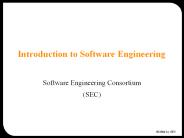Software Models (Cont.) - PowerPoint PPT Presentation
1 / 26
Title: Software Models (Cont.)
1
Software Models (Cont.)
- Component-based software engineering
- Formal Development Model
2
Objectives
- To explain that CBSE is concerned with developing
standardised components and composing these into
applications - To describe components and component models
- To show the principal activities in the CBSE
process - To discuss approaches to component composition
and problems that may arise
3
Topics covered
- Components and component models
- The CBSE process
- Component composition
4
Component-based development
- Component-based software engineering (CBSE) is an
approach to software development that relies on
software reuse. - It emerged from the failure of object-oriented
development to support effective reuse. Single
object classes are too detailed and specific. - Components are more abstract than object classes
and can be considered to be stand-alone service
providers.
5
CBSE essentials
- Independent components specified by their
interfaces. - Component standards to facilitate component
integration. - Middleware that provides support for component
inter-operability. - A development process that is geared to reuse.
6
CBSE and design principles
- Apart from the benefits of reuse, CBSE is based
on sound software engineering design principles - Components are independent so do not interfere
with each other - Component implementations are hidden
- Communication is through well-defined interfaces
- Component platforms are shared and reduce
development costs.
7
CBSE problems
- Component trustworthiness - how can a component
with no available source code be trusted? - Component certification - who will certify the
quality of components? - Emergent property prediction - how can the
emergent properties of component compositions be
predicted? - Requirements trade-offs - how do we do trade-off
analysis between the features of one component
and another?
8
Components
- Components provide a service without regard to
where the component is executing or its
programming language - A component is an independent executable entity
that can be made up of one or more executable
objects - The component interface is published and all
interactions are through the published interface
9
Component definitions
- Councill and Heinmann
- A software component is a software element that
conforms to a component model and can be
independently deployed and composed without
modification according to a composition standard. - Szyperski
- A software component is a unit of composition
with contractually specified interfaces and
explicit context dependencies only. A software
component can be deployed independently and is
subject to composition by third-parties.
10
Component as a service provider
- The component is an independent, executable
entity. It does not have to be compiled before it
is used with other components. - The services offered by a component are made
available through an interface and all component
interactions take place through that interface.
11
Component characteristics 1
12
Component characteristics 2
13
Formal Specification
14
Objectives
- To explain why formal specification techniques
help discover problems in system requirements
15
Topics covered
- Formal specification in the software process
16
Formal methods
- Formal specification is part of a more general
collection of techniques that are known as
formal methods. - These are all based on mathematical
representation and analysis of software. - Formal methods include
- Formal specification
- Specification analysis and proof
- Transformational development
- Program verification.
17
Acceptance of formal methods
- Formal methods have not become mainstream
software development techniques as was once
predicted - Other software engineering techniques have been
successful at increasing system quality. Hence
the need for formal methods has been reduced - Market changes have made time-to-market rather
than software with a low error count the key
factor. Formal methods do not reduce time to
market - The scope of formal methods is limited. They are
not well-suited to specifying and analysing user
interfaces and user interaction - Formal methods are still hard to scale up to
large systems.
18
Use of formal methods
- The principal benefits of formal methods are in
reducing the number of faults in systems. - Consequently, their main area of applicability is
in critical systems engineering. There have been
several successful projects where formal methods
have been used in this area. - In this area, the use of formal methods is most
likely to be cost-effective because high system
failure costs must be avoided.
19
Specification in the software process
- Specification and design are inextricably
intermingled. - Architectural design is essential to structure a
specification and the specification process. - Formal specifications are expressed in a
mathematical notation with precisely defined
vocabulary, syntax and semantics.
20
Specification and design
21
Specification in the software process
22
Use of formal specification
- Formal specification involves investing more
effort in the early phases of software
development. - This reduces requirements errors as it forces a
detailed analysis of the requirements. - Incompleteness and inconsistencies can be
discovered and resolved. - Hence, savings as made as the amount of rework
due to requirements problems is reduced.
23
Cost profile
- The use of formal specification means that the
cost profile of a project changes - There are greater up front costs as more time and
effort are spent developing the specification - However, implementation and validation costs
should be reduced as the specification process
reduces errors and ambiguities in the
requirements.
24
Development costs with formal specification
25
Specification techniques
- Algebraic specification
- The system is specified in terms of its
operations and their relationships. - Model-based specification
- The system is specified in terms of a state model
that is constructed using mathematical constructs
such as sets and sequences. Operations are
defined by modifications to the systems state.
26
Formal specification languages































